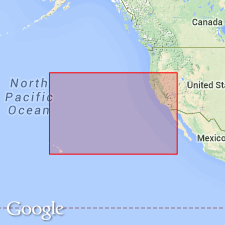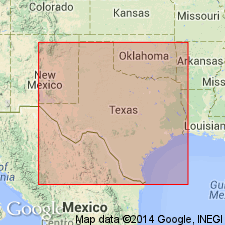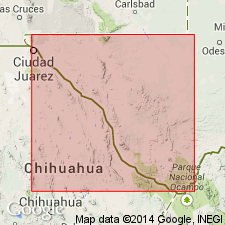
- Usage in publication:
-
- [Alamo Creek Basalt Member]
- Modifications:
-
- Geochronologic dating
- AAPG geologic province:
-
- Permian basin
Summary:
Pg. 165, 193. [Alamo Creek Basalt Member of Chisos Volcanic Formation.] Potassium-argon (K-Ar) date 42.7 Ma. Basalt dated is lowest flow in Chisos Volcanic Formation.
Source: US geologic names lexicon (USGS Bull. 1350, p. 10-11).

- Usage in publication:
-
- Alamo Creek Basalt Member
- Modifications:
-
- Areal extent
- AAPG geologic province:
-
- Permian basin
Summary:
Pg. 23, 25, 33, road logs. Alamo Creek Basalt Member of Chisos Formation of Big Bend Park Group. Lowermost of named flows in formation in Big Bend National Park. Underlies Ash Spring Basalt Member. At all places in southwest, west, and northwest of Chisos Mountains, where Tertiary-Cretaceous contact is exposed, the Alamo Creek rests on erosion surface in Javelina Formation (new). Locally underlies Burro Mesa Riebeckite Rhyolite Member of South Rim Formation (new). Age is late Eocene.
Source: US geologic names lexicon (USGS Bull. 1350, p. 10-11).

- Usage in publication:
-
- Alamo Creek Basalt Member
- Modifications:
-
- [Principal reference]
- Dominant lithology:
-
- Basalt
- AAPG geologic province:
-
- Permian basin
Summary:
Pg. 115-116, pls. Alamo Creek Basalt Member of Chisos Formation. Formal proposal of name. Most of the Alamo Creek Basalt is a fine-grained hard dark lava. Locally, small phenocrysts. Base usually scoriaceous and commonly contains inclusions. Thickness 20 to 208 feet. Thickest exposures are southwest of highest Chisos Mountains peaks-Kitt Mountain-Round Mountain-Cerro Castellan area. Lava thins northwestward and southeastward from that area. Is lowest unit of western Chisos Formation facies and does not extend east of a structural barrier that is near line drawn from high part of central Chisos Mountains southeastward along crest of Cow Heaven anticline. Underlies Ash Spring Basalt Member of Chisos. Overlies Javelina Formation. Age is late Eocene.
Named from Alamo Creek, west of Chisos Mountains, where the lava is exposed almost continuously from near Dawson Creek southward to the Rio Grande, Brewster Co., southwestern TX. [= type locality (see C.D. Henry and L.L. Davis, 1996, Univ. Texas-Austin Bur. Econ. Geol. Rpt. Inv., no. 240, p. 81-105).]
Source: US geologic names lexicon (USGS Bull. 1350, p. 10-11).

- Usage in publication:
-
- Alamo Creek Basalt [Member]
- Modifications:
-
- Geochronologic dating
- AAPG geologic province:
-
- Permian basin
Summary:
Pg. 25. Alamo Creek Basalt [Member] of Chisos Formation. Basalt samples from Cerro Castellan, Tule Mountain, and Castolon quadrangles, Brewster County, southwestern Texas, yielded K-Ar ages from 46.9 +/-1.1 Ma to 43.8 [+/-?] Ma (plagioclase, whole-rock). Data from J.F. Evernden and others, 1964 (Amer. Jour. Sci., v. 262, p. 145-198), and R.A. Maxwell and others, 1967 (Univ. Texas-Austin Pub. 6711, 320 p.); ages recalculated using decay constants of Steiger and Jager, 1977 (Earth Planet. Sci. Letters, v. 36, p. 359-362). [Age considered Eocene (from Geologic Names Committee, USGS, 1983 ed. geol. time scale, with additions from N.J. Snelling, 1985, The Geol. Soc. Mem., no. 10).]
Source: Publication.
For more information, please contact Nancy Stamm, Geologic Names Committee Secretary.
Asterisk (*) indicates published by U.S. Geological Survey authors.
"No current usage" (†) implies that a name has been abandoned or has fallen into disuse. Former usage and, if known, replacement name given in parentheses ( ).
Slash (/) indicates name conflicts with nomenclatural guidelines (CSN, 1933; ACSN, 1961, 1970; NACSN, 1983, 2005, 2021). May be explained within brackets ([ ]).

